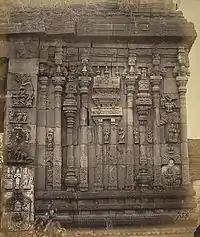
| Founder | |
|---|---|
| Srimad Athivan Satakopan | |
| Religions | |
| Hinduism | |
| Website | |
| www.ahobilamutt.org |
The Ahobila Matha is a Vadakalai Sri Vaishnava monastery established around 1400 CE at Ahobilam in Andhra Pradesh, India following the Vadakalai tradition of Vedanta Desika.[1] It is attributed to Sri Adivan Satakopa Swami (originally known as Srinivasacharya).[2][3][4]
Sri Adhivan Satakopa, a Vadakalai saint,[5] who was a great grand disciple of Vedanta Desika[6][7] and a sishya of Ghatikasatham Ammal, the scholarly successor of the celebrated Sri Vaishnava stalwart Nadadoor Ammal,[8] founded and established the Matha, based on the Pancharatra tradition.[9][10][11][12]
The Matha
As per legend, one of the nine Narasimhas of Ahobilam called Lord Malolan jumped into the hands of Srinivasacharya and ordered him to travel the length and breadth of the country.
Current Acharya

The current Acharya is the 46th Jeeyar Srivan Satakopa Sri Ranganatha Yateendra Mahadesikan. He succeeded the previous pontiff 45th Jeeyar Sri Lakshmi Nrsimha Divya Paduka Sevaka Srivan Satakopa Sri Narayana Yateendra Mahadesikan who attained Acharyan Thiruvadi on 19 May 2013 following a prolonged illness.
Temples under purview
Several temples such as the Nine (Nava) Narasimha temples of Ahobilam, Veeraraghava temple in Tiruvallur and Valvil Rama temple, Aandalakkum ayyan temple in the outskirts of Kumbakonam (Pullaboothankudi), are administered by Ahobila Matha.
The Matha also has several branches across India.
Sri Ahobila Matha Lakshmi Narasimha Lakshmi Narayana Temple, Ahobila Matha Marg, Chembur in Mumbai. The Ahobila Matha temple in Chembur, Established in 1968, is a preeminent religious center in this northern suburb of Mumbai.
Institutions administered

The Ahobila Matha has several religious and educational institutions in India which are:[13]
- Sri Ahobila Matha Sanskrit College (Est. 1942)
- Sri Ahobila Matha Veda Patashala (Est. 1942)
- Sri Ahobila Matha Oriental High School (Est. 1952)
- Sri Ahobila Matha Center for Human Resource Development (Est. 2002)
- Sri Malolan College of Arts and Science, Madurantakam, (Est. 2009)
See also
References
- ↑ S Rath (2012). Aspects of Manuscript Culture in South India. BRILL Academic. pp. 246–247 with footnotes. ISBN 978-90-04-22347-9.
- ↑ Pg.557 The History and Culture of the Indian People: The Delhi sultanate; Bharatiya Vidya Bhavan, Bhāratīya Itihāsa Samiti
- ↑ Pg.211 Report on the inscriptions of the Devasthanam collection, with illustrations, Sadhu Subrahmanya Sastry, Kallidaikurichi Aiyah Nilakanta Sastri, K.P. Bagchi & Co., 1998
- ↑ Pg.105 The Temple of Lord Varadaraja, Kanchi: a critical survey of Dr. K. V. Raman's Sri Varadarajaswami Temple, Kanchi
- ↑ Pg.36 Hindu and Muslim religious institutions, Andhra Desa, 1300-1600; New Era, 1984
- ↑ Pg.18 Śrī Vedānta Deśika - By Mudumby Narasimhachary, Sāhitya Akādemī ISBN 81-260-1890-9
- ↑ Pg.57 The history of the Vijayanagar Empire, Volume 1; M. H. Rāma Sharma, Popular Prakashan, 1978.
- ↑ Pg.129 Studies in social history:modern India, O. P. Bhatnagar, India. University Grants Commission, University of Allahabad. Dept. of Modern Indian History; St. Paul's Press Training School, 1964.
- ↑ Tirupati Balaji was a Buddhist shrine, Sanjivan Publications, 1991
- ↑ "Vadakalai Srivaishnava Festivals' Calendar - The source mentions Pancharatra & Munitraya Krishna Jayantis celebrated by Ahobila Matha & Andavan Ashrams respectively". Archived from the original on 2011-10-03. Retrieved 2011-09-25.
- ↑ Ahobila Matha's Balaji Mandir Pune, Calendar - The calendar mentions Ahobila Matha disciples celebrating Krishna Jayanti as "Pancharatra Sri Jayanti". Archived 2011-10-09 at the Wayback Machine
- ↑ Pg.306 Report of the Sanskrit Commission, 1956-1957; India. Saṃskr̥ta Āyoga- Manager of Publications, 1958